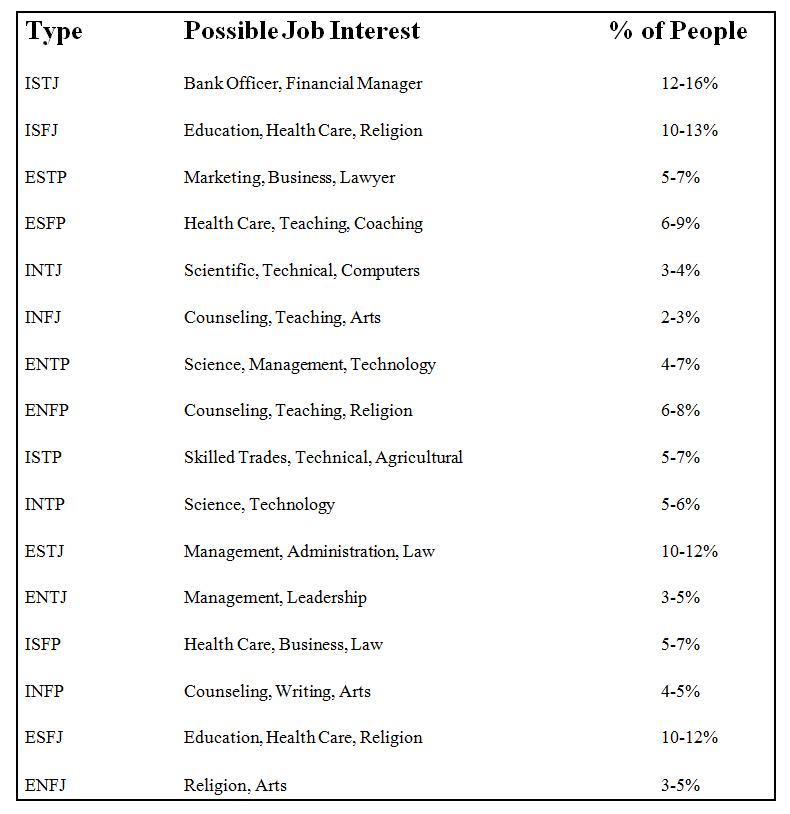Can’t Afford to Take the Myers Briggs MBTI? A Free Way to Determine Your Personality Type and Job Preferences
Can’t Afford to Take the Myers Briggs MBTI? A Free Way to Determine Your Personality Type and Job Preferences
Myers Briggs MBTI personality assessment is one of the most reliable and valid instruments on the market. Employers and job-seekers alike have found the results to be useful to explain personality preferences and match job applicants to appropriate positions. However, in a tough economy, not everyone has the financial resources to take the actual MBTI. While, there are a lot of free MBTI-like tests on the Internet, most of them are set up to obtain your email address for future promotions. Although I highly recommend taking the actual MBTI, there are other ways to get an idea of your individual personality preferences. The following is not nearly as reliable or valid as taking the actual MBTI, but it can give you some insight as to where you fall within the personality types described by Myers Briggs.
Wikipedia does a nice job of explaining the MBTI model and Myers Briggs work. The site explains that “individuals are either born with, or develop, certain preferred ways of thinking and acting. The MBTI sorts some of these psychological differences into four opposite pairs, or dichotomies, with a resulting 16 possible psychological types. None of these types are better or worse; however, Briggs and Myers theorized that individuals naturally prefer one overall combination of type differences. In the same way that writing with the left hand is hard work for a right-hander, so people tend to find using their opposite psychological preferences more difficult, even if they can become more proficient (and therefore behaviorally flexible) with practice and development. The 16 types are typically referred to by an abbreviation of four letters—the initial letters of each of their four type preferences (except in the case of intuition, which uses the abbreviation N to distinguish it from Introversion). For instance:
- ESTJ: extraversion (E), sensing (S), thinking (T), judgment (J)
- INFP: introversion (I), intuition (N), feeling (F), perception (P)
And so on for all 16 possible type combinations.” In order to discover your 4 letter type, you must consider how you prefer to obtain information, what energizes you, how you make decisions and how you approach life. The chart below lists some words and phrases that may best describe your personality.
Using the chart listed above, look at the qualities listed under each of the headings and pick the letter that best represents you. You will pick either either an E or I for extroversion or introversion; an S or N for sensing or intution; a T or F for thinking or feeling; and a J or P for judgement or perception as the personality type that you feel best represents you based on the words listed below each heading. In the end you will have a 4 letter type. Once you know that 4 letter type, you can look at the chart below to look at jobs that match well with your personality preferences.
There is no shortage of information on the Internet regarding jobs that match MBTI results. Once you are able to obtain your 4 letter “type”, you can search for more information about that type online. For more information about personalities and type, check out: It’s Not You It’s Your Personality.
Related Articles
- Top 10 Personality, Career, IQ and EQ Tests
- Charlie Sheen: Narcissist and ENFP Personality Type? (drdianehamilton.wordpress.com)
- Sue Sylvester from Glee: Classic ESTJ MBTI Type (drdianehamilton.wordpress.com)
- Jobs and Education Preferences Based on Your Myers-Briggs MBTI Type (drdianehamilton.wordpress.com)
- What is Your Favorite Celebrity’s Personality Type? See How Your Personality Compares to Theirs (drdianehamilton.wordpress.com)
- Oprah, Ellen Degeneres, and George Carlin: What Their Personalities All May Have in Common (drdianehamilton.wordpress.com)

